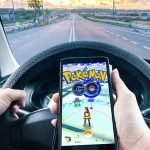It doesn’t take a Harvard researcher to know that driving while talking or texting on a handheld cell phone might distract you enough to cause an accident. And yet, many people disregard this obvious fact, thinking they can remain alert enough to be safe as they communicate with Aunt Millie on the freeway, much like drunk drivers who think they’re still in control of the vehicle. In fact, research shows that driving while using a cell phone may actually be more dangerous than drunk driving. A British study found that reaction times were 30 percent slower when holding a cell phone and talking than when legally drunk.1 Plus, the cell phone impaired drivers had more trouble maintaining a safe distance from cars ahead of them than drunk drivers did, and they were less able to keep a consistent speed. A US study had slightly more positive results, finding that driving while talking on the cell phone was merely as bad as driving with a blood alcohol level of .08 percent — the legal limit defining intoxication — not worse.
According to a 2009 New York Times study, 11 percent of all drivers on the road are blabbing away on their cell phones at any given time.2 A separate Harvard study shows that cell phone talking causes more than half a million accidents annually and leads to 2,600 deaths. Viewed another way, distraction caused 16 percent of all road fatalities in 2009 plus 20 percent of all injuries, and that number continues to rise. But these statistics grossly underestimate the real story, because few drivers will admit to talking or texting after having an accident — either because it’s illegal or because it’s embarrassing. We figure we should know better.
And it’s especially embarrassing because we’ve all been led to believe there’s get-out-of-jail-free card here — a way to use the phone safely while on the road. Most of us believe that doing the talking hands free makes it a whole lot safer. In fact, eight states in the US have passed legislation making it illegal to talk while holding the cell phone, but quite legal to talk hands-free, indicating an implicit belief that using a bluetooth or a speakerphone provides safety.3 After all, most drivers talk to passengers without a problem, so it makes sense that it would be just as safe to talk to someone on the other end of the receiver. Unfortunately, research shows it ain’t necessarily so.
Studies have found that the brain works extra-hard to process communications from a person who isn’t physically present. A study from Carnegie-Mellon Institute found that listening to someone speak on the phone causes activity in the part of the brain that processes movement and spatial relations to decrease by 37 percent. Obviously, you need good spatial relations to avoid crashing into objects while driving, and so that level of impairment poses an extra risk. And then, a University of South Carolina study found that speaking on the cell phone is four times more distracting than listening, meaning that you even more severely compromise your ability to judge the road when you talk.4 I guess the old adage about God giving you two ears and one mouth so you listen twice as much as you talk is especially apropos when it comes to using a cell phone while driving. Or not…
What exacerbates this issue is the fact that the party at the other end of a cell phone conversation hasn’t a clue what circumstances you’re dealing with. In other words, when a passenger who is physically present with you and talking to you while you drive, that person sees oncoming traffic just as you do, and will normally adjust conversation to accommodate traffic realities. But if you’re on the phone, the person on the other end just keeps yapping even as the truck that just jumped the divider lines heads straight towards you in your lane. And that’s why talking on the cell, even hands free, quadruples your accident risk.
If talking on the cell phone seems risky, texting while driving seems so patently stupid that it’s hard to believe people do it, and yet, the Pew Research Center found that 27 percent of all adults have, in fact, read or written texts while behind the wheel.5 Surprisingly, adults actually outpace teens by a tiny margin when it comes texting on the road. Adults also outpace teens when it comes to talking and driving: only 43 percent of teens admit to conversing on their cell phone while behind the wheel, compared to 67 percent of adults. In any case, it’s no surprise that studies have found a link between punching a message into the phone and crashing the vehicle. A study by the Virginia Tech Transportation Institute (VTTI) found that texting while driving increased accident risk by 20 percent.
Again, there’s little surprising about these statistics. It would take vast oblivion to not realize you have to watch the road and be alert and attentive when driving. And yet, legislators, manufacturers, and the public seem united in a league of denial aimed at allowing drivers to multi-task while on the road. Evidence the fact that 24 states allow drivers to send and receive texts. Even more alarming is the fact that 34 states let bus drivers do their texting while driving. Inconceivable!!
The problems associated with cell phone use on the road also have contaminated air travel. Several notorious airline mishaps have resulted from pilots distracted by their cell phones or computers.6 While most major airlines prohibit pilots from texting while flying their aircraft, investigative reports have found numerous abuses. Plus, recent horrifying reports that air traffic control mistakes have doubled in the past year come with complaints about personnel glued to their electronic toys, including cell phones, instead of watching the controls.7
And then, of course, there’s the infamous Chatsworth Train Disaster, the largest Metrolink train accident in US history, in which the engineer blew right through the red-light stop-signal because he was busy texting and didn’t see it. He ran head on into a freight train at a combined speed of over 80 mph.8
The solution seems as obvious as the old, “Don’t drink and drive” advice. But “don’t” isn’t a word that cell phone users easily respond to. One of the main problems centers around economics. First, there’s the problem of increasing work demands impinging on people so much that they can’t afford downtime even when driving, so they do business behind the wheel. Employers don’t necessarily discourage this practice and, in fact, may even promote it. Then from another angle, the technology industry benefits whenever people plug in. In spite of the obvious dangers, car manufacturers have partnered with companies like Google and Intel to bring the internet to the dashboard.9 As far as the cell phone goes, the more minutes the people use, the more money there is to be made. And there’s money to be made from hands-free devices and navigation tools. Outlawing cell phone use while driving would put a big dent in some big budgets.
But it seems in this world, wherever there’s a problem, there’s an entrepreneur with a possible solution, and so it goes in this case, too. Engineers at Microsoft have come up with “semi-smart mediation technology” that senses road conditions and cuts off conversations when dangers appear in the roadway.10 The technology comes in the form of a device that makes announcements like “Focus needed,” and “Residential neighborhood ahead with children playing.” In trial runs using the device, drivers had 27 percent fewer crashes and 81 percent fewer turning errors than a control group of cell phone using drivers. If the device makes it to market, it could be great news for corporate America, meaning employees will have no excuse to go off-line during the commute home.
But until these safety devices become available, it does make sense to put the cell phone on mute and turn off the ringer when you drive. You might as well notice the scenery and enjoy the ride before “progress” renders such nonproductive activities extinct.
1 “Study: Talking on a Phone Worse than Driving Drunk.” 1.800.DUI.Laws. 11 July 2011. <http://www.1800duilaws.com/dui-articles/study_dui_ws_talking_on_cellphone.asp>
2 “Driven to Distraction.” 11 July 2011. The New York Times. 11 July 2011. <http://topics.nytimes.com/top/news/technology/series/driven_to_distraction/index.html>
3 “Think before you speak.” 14 April 2011. The Economist. 11 July 11, 2011. < http://www.economist.com/node/18561075>
4 “Dangers of talking while driving explained.” 2 June 2008. Reuters. 11 July 2011. < http://www.reuters.com/article/2008/06/02/us-driving-cellphone-idUSN3039216720080602>
5 Kolakowski, Nicholas. “Texting While Driving Common Among Adults, Says Study.” 26 June 2010. Eweek.com. 11 July 2011. < http://www.eweek.com/c/a/Mobile-and-Wireless/Texting-While-Driving-Common-Among-Adults-Says-Study-101117/>.
6 “Latest flying fear? Pilot distraction.” 27 October 2009. The Wenatche World. 11 July 2011. < http://www.wenatcheeworld.com/news/2009/oct/27/latest-flying-fear-pilot-distraction/>
7 Lowy, Joan. “Reported Errors Double in Air Traffic Control.” 11 February 2011. ABC News. 11 July 2011. < http://abcnews.go.com/US/wireStory?id=12890801>
8 “2008 Chatsworth train collision.” Wikipedia. Accessed 11 July 2011. <http://en.wikipedia.org/wiki/2008_Chatsworth_train_collision>
9 Vance, Ashlee and Richtel, Matt. “Despite Risks, Internet Creeps onto Car Dashboards.” 6 January 2010. The New York Times. 11 July 2011. < http://www.nytimes.com/2010/01/07/technology/07distracted.html>.
10 Lohr, Steve. “Distracted Driving: An Answer Perhaps?” 9 May 2011. New York Times. 11 July 2011. < http://bits.blogs.nytimes.com/2011/05/09/distracted-driving-an-answer-perhaps/>











